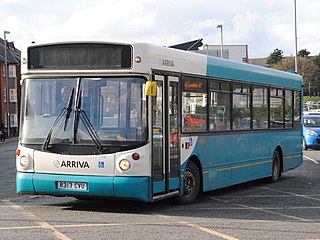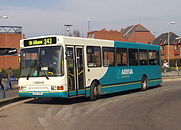
Wrightbus is a Northern Irish bus manufacturer and a pioneer of the low-floor bus. The company was established in 1946 by Robert Wright and was later run by his son William Wright, until it was acquired in 2019 by British businessman Jo Bamford.

The Alexander ALX200 was a single-decker bus body built by Alexander of the United Kingdom. It was created for low-floor bus chassis produced from the late 1990s and was launched in spring 1996 as a low-floor replacement of the Alexander Dash. It was marketed in Alexander's 'ALX' series to fill in the gap between the ALX100 minibus and the ALX300 full-size single-decker.

Duple Coachbuilders was a coach and bus bodybuilder in England from 1919 until 1989.
Walter Alexander Coachbuilders was a Scottish builder of bus and coach bodywork based in Falkirk. The company was formed in 1947 to continue the coachbuilding activities of W. Alexander & Sons when their bus service operation was nationalised. After several mergers and changes of ownership it now forms part of Alexander Dennis.

East Lancashire Coachbuilders Limited was a manufacturer of bus bodies and carriages founded in 1934 in Blackburn, Lancashire, England. The company went into administration for a short while in August 2007, before being bought by Darwen Group and performed a reverse takeover with Optare when its parent purchased the company in 2008 and its site and business was later closed in 2012.

The Dennis Lance was a single-decker bus chassis manufactured by Dennis between 1991 and 2000, replacing the Dennis Falcon. Its low floor variant, the Dennis Lance SLF was built between 1993 and 1996. Between 1995 and 1998, Dennis also built its double-deck variant, the Dennis Arrow, as the replacement of the Dennis Dominator.

The East Lancs Myllennium was a type of single-decker bus body manufactured by East Lancashire Coachbuilders on DAF SB220, Dennis Dart SLF, MAN 14.220 and Scania N94UB chassis. It was superseded by the East Lancs Esteem in 2006.

The Plaxton Paramount was a design of coach bodywork built by Plaxton. It first appeared at the 1982 British Motor Show and was built until 1992.

The Plaxton Verde was a step-entrance full-size single-decker bus body built by Plaxton between 1991 and 1997. It was built on a rear-engined chassis, the most popular of which was the Dennis Lance which accounted for over half of the Verdes built. The rest were on Volvo B10B, DAF SB220 and Scania N113 chassis.

The Wright Crusader was a single-decker bus body built on Dennis Dart SLF, Volvo B6LE and Volvo B6BLE chassis by Wrightbus between 1995 and 2002.

The East Lancs EL2000 is a type of single-decker bus body built on a wide variety of bus chassis by East Lancashire Coachbuilders.

The East Lancs 1984-style double-deck body is a type of double-decker bus body with a step-entrance, built on several different chassis by East Lancashire Coachbuilders in England.

The East Lancs Flyte is a type of single-decker bus body built on several different chassis rebodied and original types by East Lancashire Coachbuilders as the replacement for the East Lancs EL2000 from 1996 to 2001.

The Plaxton Prestige is a low-floor single-decker bus body built by manufacturers Northern Counties and Plaxton between 1996 and 1999.

The Northern Counties Palatine was a step-entrance 2-axle and 3-axle double-decker bus body built by Northern Counties from 1988 to 1999 in Wigan, England.

The Wright Endurance was a step-entrance single-decker bus body on Scania N113 and on Volvo B10B chassis by Wrightbus between 1992 and 1997.

A single-decker bus or single-decker is a bus that has a single deck for passengers. Normally the use of the term single-decker refers to a standard two-axled rigid bus, in direct contrast to the use of the term double-decker bus, which is essentially a bus with two passenger decks and a staircase. These types of single-deckers may feature one or more doors, and varying internal combustion engine positions. The majority of single-deckers have a length of up to 12 metres, although some exceptions of longer buses exist. They also typically weigh between 11 and 14 tons.

The Alexander Strider was a single-decker bus body produced in Scotland by Walter Alexander Coachbuilders between 1993 and 1997. The body was available on Dennis Lance, Volvo B10B, Volvo B10M and Scania L113 chassis. In 1993, the body was modified briefly to fit the Mercedes-Benz O405/O405G chassis and was marketed as the Alexander Cityrider. Only two were built on this chassis configuration.

The Volvo B10B was a rear-engined step deck single-decker bus chassis manufactured by Volvo between 1992 and 2001. The first prototype were built in 1990, but the B10B wasn't launched until the 1992 Geneva Motor Show. It superseded the Leyland Lynx and Volvo B10R. For stage use it was gradually succeeded by the low-entry B10BLE, which was introduced only a year later, though not in all markets. For interurban use the B7R came as a gradual replacement in 1998, and ultimately for coach work, the B12B took over in 2001.























